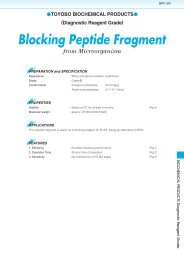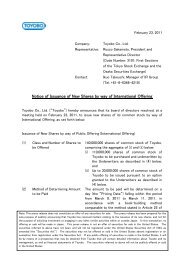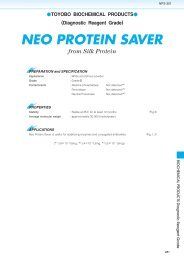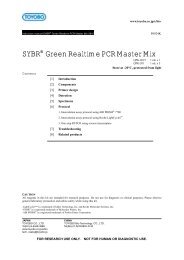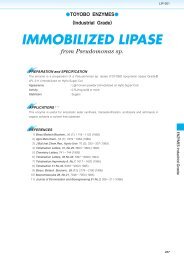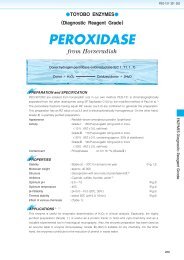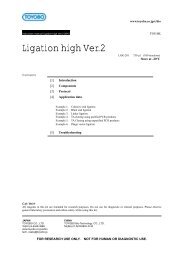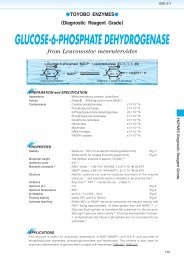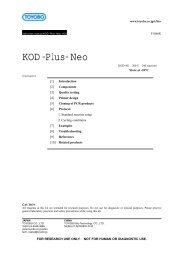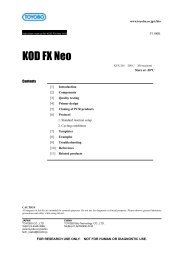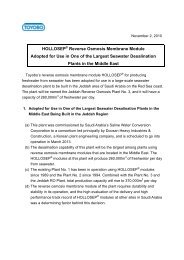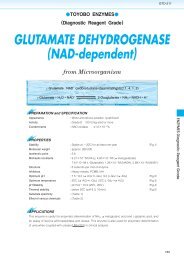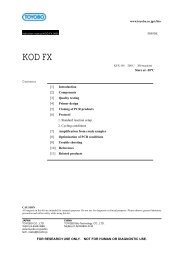DIAPHORASE - Toyobo
DIAPHORASE - Toyobo
DIAPHORASE - Toyobo
Create successful ePaper yourself
Turn your PDF publications into a flip-book with our unique Google optimized e-Paper software.
DAD-301<br />
TOYOBO ENZYMES<br />
(Diagnostic Reagent Grade)<br />
<strong>DIAPHORASE</strong><br />
from Clostridium sp.<br />
NAD(P)H:(acceptor)oxidoreductase (EC 1.6.99. )<br />
NAD(P)HH Acceptor(ox)<br />
NAD(P) Acceptor(red)<br />
PREPARATION and SPECIFICATION<br />
Appearance<br />
: Yellowish amorphous powder, lyophilized<br />
Activity<br />
: Grade30U/mg-solid or more<br />
(containing approx. 15% of stabilizers)<br />
Contaminants : Myokinase ≤5.010 1 %<br />
NAD(P)H oxidase ≤5.010 1 %<br />
Stabilizers<br />
: FMN, NAD(P)H<br />
PROPERTIES<br />
Stability : Stable at 20 for at least one year Fig.1<br />
Molecular weight<br />
: 24,000 1<br />
Michaelis constants<br />
: 2.010 5 M (NADH), 6.010 6 M (NADPH)<br />
Structure<br />
: One mol of FMN per mol of enzyme 1<br />
Inhibitor<br />
: N-Ethylmaleimide<br />
Optimum pH : 8.5 Fig.2<br />
Optimum temperature : 50 Fig.3<br />
pH Stability : pH 7.5 (30, 3hr) Fig.4<br />
Thermal stability : below 30 (pH 7.5, 30min) Fig.5<br />
Substrate specificty<br />
: Either NADH or NADPH can be used as a reductant. The catalytic<br />
ratio (NADPH/NADH) is 0.6 in the assay method. Neither oxygen nor<br />
cytochrome C can be utilized as a hydrogen acceptor.<br />
APPLICATIONS<br />
This enzyme is useful for colorimetric determination of NAD(P)H and many dehydrogenases when<br />
coupled with various dyes which act as hydrogen acceptors from NAD(P)H.<br />
81
DAD-301<br />
ASSAY<br />
Principle:<br />
NADHH DCPIP<br />
diaphorase<br />
NAD Leucodye<br />
The reduction of DCPIP (2,6-dichlorophenol-indophenol) is measured at 600nm by spectrophotometry.<br />
Unit definition:<br />
One unit causes the decrease of one unit absorbance (1.0) of DCPIP per minute under the condeitions described<br />
below.<br />
Method:<br />
Reagents<br />
A. Buffer solution<br />
B. NADH solution<br />
C. DCPIP solution<br />
D. Enzyme diluent<br />
0.2M Tris-HCl, pH 7.5<br />
6.0mM (Prepare freshly and store on ice)<br />
1.2mM 3.9mg DCPIP2H 2 O/10ml of H 2 O(Should be prepared fresh)<br />
Buffer solution(A) containing 0.1% of bovine serum albumin.<br />
Procedure<br />
1. Prepare the following reaction mixture in a cuvette (d1.0cm) and Concentration in assay mixture<br />
equilibrate at 25 for about 5 minutes.<br />
Tris buffer<br />
27 mM<br />
2.4ml H 2 O<br />
NADH<br />
0.20mM<br />
DCPIP<br />
40 M<br />
0.3ml Buffer solution (A)<br />
BSA<br />
ca.33g/ml<br />
0.1ml NADH solution (B)<br />
2. Add 0.1ml each of the enzyme solution and DCPIP solution (C) in this order and mix by rapid<br />
inversion.<br />
3. Record the decrease of optical density at 600nm against water for 2 to 3 minutes in a<br />
spectrophotometer thermostated at 25, and calculate theOD per minute from the initial linear<br />
portion of the curve (OD test).<br />
At the same time, measure the blank rate (OD blank) by using the same method as the test except that<br />
the enzyme diluent is added instead of the enzyme solution.<br />
<br />
Dissolve the enzyme preparation in ice-cold buffer solution (A) (ca.1.0% solution ), dilute to 0.40.8U/ml<br />
with ice-cold enzyme diluent (D) and store on ice.<br />
Calculation<br />
Activity can be calculated by using the following formula<br />
Volume activity (U/ml) <br />
OD/min (OD testOD blank)df<br />
1.0Vs<br />
Weight activity (U/mg)(U/ml)1/C<br />
Vs Sample volume (0.1ml)<br />
1.0 Unit absorbance at 600nm due to unit definition<br />
df Dilution factor<br />
C Enzyme concentration in dissolution (c mg/ml)<br />
OD/min10df<br />
REFERENCES<br />
1) F.Kaplan, P.Setlow and N.O.Kaplan; Arch,Biochem.Biophys., 132, 91 (1969).<br />
82
DAD-301<br />
Table 1. Effect of Various Chemicals on Diaphorase<br />
The enzyme dissolved in 0.2M Tris-HCl buffer, pH 7.5 (40U/ml) was incubated with each chemical at 25 for<br />
1hr.<br />
Chemical<br />
None<br />
Metal salt<br />
MgCl 2<br />
CaCl 2<br />
Ba(OAc) 2<br />
FeCl 2<br />
CoCl 2<br />
MnCl 2<br />
ZnCl 2<br />
Cd(OAc) 2<br />
NiCl 2<br />
CuSO 4<br />
Pb(OAc) 2<br />
AgNO 3<br />
HgCl 2<br />
PCMB<br />
MIA<br />
Residual<br />
Concn.(mM)<br />
activity<br />
100%<br />
2.0<br />
2.0<br />
1.0<br />
99<br />
102<br />
100<br />
90<br />
101<br />
96<br />
100<br />
100<br />
99<br />
87<br />
88<br />
103<br />
103<br />
90<br />
100<br />
Chemical<br />
NaF<br />
NaN 3<br />
EDTA<br />
O-Phenanthroline<br />
,-Dipyridyl<br />
Borate<br />
IAA<br />
NEM<br />
Hydroxylamine<br />
Triton X-100<br />
Briji 35<br />
Tween 20<br />
Span 20<br />
Na-cholate<br />
SDS<br />
DAC<br />
Concn.(mM)<br />
2.0<br />
2.0<br />
5.0<br />
2.0<br />
1.0<br />
5.0<br />
2.0<br />
2.0<br />
2.0<br />
0.10%<br />
0.10%<br />
0.10%<br />
0.10%<br />
0.10%<br />
0.05%<br />
0.05%<br />
Residual<br />
activity<br />
102<br />
100<br />
99<br />
99<br />
101<br />
100<br />
99<br />
100<br />
101<br />
106<br />
104<br />
107<br />
101<br />
99<br />
32<br />
32<br />
100<br />
100<br />
100<br />
Residual Activity,%<br />
50<br />
-20<br />
5<br />
25<br />
40<br />
Relative Activity<br />
50<br />
Residual Activity,%<br />
50<br />
0 3 7 14 4 8 12<br />
(days)Period(months)<br />
Fig.1. Stability (Powder form)<br />
kept under dry conditions<br />
0<br />
6<br />
pH<br />
Fig.2. pH-Activity<br />
7<br />
8<br />
9<br />
10<br />
The enzyme reaction was carried out with<br />
NADH()or NADPH().buffer used:<br />
pH6.0-7.5, 10mM Veronal-acetate;<br />
pH7.5-9.0, 33mM Tris-HCI;<br />
pH9.2-10.2, 33mM NH4OH-NH4OH<br />
0<br />
pH<br />
Fig.4. pH-Stability<br />
5<br />
6<br />
7<br />
30,3hr-treatment with the following<br />
buffer solution: pH6.0-7.5, 10mM Veronalacetate;<br />
pH7.5-9.0, 33mM Tris-HCI<br />
8<br />
9<br />
Relative Activity<br />
100<br />
50<br />
Residual Activity,%<br />
100<br />
50<br />
0<br />
30<br />
40<br />
50 60<br />
Temperature, <br />
Fig.3. Temperature activity<br />
The enzme reaction was carried out<br />
with NADH()or NADPH().<br />
20mM Tris-HCI buffer,pH8.5<br />
0<br />
20<br />
30<br />
40<br />
50<br />
60<br />
Temperature, <br />
Fig.5. Thermal stability<br />
30min-treatment with 0.2M<br />
Tris-HCI buffer,pH7.5<br />
enzyme concentration:40U/ml<br />
83
DAD-301<br />
<br />
<br />
diaphorase<br />
<br />
<br />
<br />
<br />
<br />
<br />
<br />
<br />
<br />
2 <br />
P<br />
<br />
<br />
<br />
P<br />
<br />
<br />
<br />
<br />
P <br />
P <br />
P <br />
P<br />
<br />
<br />
<br />
<br />
<br />
P<br />
<br />
<br />
<br />
<br />
P<br />
P <br />
<br />
P <br />
<br />
<br />
P<br />
84



